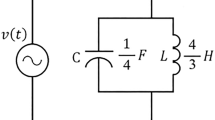Abstract
This paper attempts to provide a clear explanation of how the concept of double frequency complex plane is applied to the calculation of complex electrical power. This is a step to remove the confusion associated with the calculation of complex electrical power that has persisted in the scientific community to this day. It starts with a discussion on the conventional method of calculation of complex power and its relation with the Steinmetz’s original method of power calculation in steady state AC circuit. An excerpt from the writing of Steinmetz is then included in which he enumerated mathematical equations that were used to make adjustments while calculating two times the supply frequency complex electrical power from the supply frequency complex voltage and current. Since the equations appear to contradict the laws of conventional complex algebra, considerable confusion arose soon after the Steinmetz’s publication. This confusion persists even today. Usual text books do not touch upon this issue and merely describe the mathematical equation required for calculation of complex power. This paper tries to provide a justification behind the adjustment equations involving double frequency complex plane used for complex power calculation through a simple R-L circuit and provide analytical explanation of the equations enumerated by Steinmetz.






Similar content being viewed by others
Abbreviations
- V :
-
Complex voltage
- I :
-
Complex current
- S :
-
Complex power
- v1 :
-
Real part of V
- v11 :
-
Imaginary part of V
- i1 :
-
Real part of I
- i11 :
-
Real part of I
- P:
-
Active power, real part of S
- Q:
-
Reactive power, imaginary part of S
- is(t):
-
Instantaneous source current
- Is :
-
RMS value of source current
- vs(t):
-
Instantaneous source voltage
- Vs :
-
RMS value of source voltage
- pR(t):
-
Instantaneous power delivered to the resistor R
- pL(t):
-
Instantaneous power delivered to the inductor L
- VR :
-
RMS value of the voltage across R
- VRm :
-
Peak value of the voltage across R
- VL :
-
RMS value of the voltage across L
- Lm :
-
Peak value of the voltage across L
- \(\upomega \) :
-
Angular frequency of supply voltage and current
- \(\uptheta \) :
-
Load power factor angle
- 1 ω :
-
Unit real number in ω plane
- 1 2ω :
-
Unit real number in 2ω plane
- j ω :
-
Unit imaginary number in ω plane
- j 2ω :
-
Unit imaginary number in 2ω plane
References
Kline R R 1992 Steinmetz Engineer and Socialist. The John Hopkins University Press, Baltimore and London, Baltimore
Steinmetz P C 1900 Theory and Calculation of Alternating Current Phenomena. 3rd Edition, Revised and Enlarged, Electrical World and Engineer Incorporated, New York, pp 1–2, pp 150–152
Kennelly E A 1910 Vector Power In Alternating-Current Circuits. Proc. of A.I.E.E. 27(7) : 1023–1057
Gleen W D 2006 Electric Power Industry in non technical language. 2nd edn. Pennwell Books, Tulsa, Oklahoma
Lacour J L and Bragstad O S 1913 Theory and calculations of electric currents. Longmans, Green and Co. pp 37–38
Petroianu I A 2014 Mathematical representations of electrical power: vector or complex number? Neither! IEEE Electrical Power and Energy Conference, Calgary, AB, Canada, 170–177
Petroianu I A 2015 A geometric algebra reformulation and interpretation of Steinmetz’s symbolic method and his power expression in alternating current electric circuits. Electrical Engineering Springer 97(3): 175–180
Koteshwara Rao U K and Mishra K M 2012 Review of Power Decompositions and Theories for Load Compensation. Journal of Electrical Engineering 12: 20–30
Whitehead J B 1901 Review of Alternating Current Phenomenon ( by C. P. Steinmetz). Physical Review: 399–408
Berg E J and Upson W L 1916 Electrical Engineering 1stcourse (Book). 1st edn. McGraw Hill Book Company, New York, page 116
Franklin W S and Esty W 1908 The Elements of Electrical Engineering – Vol. II Alternating Currents. 2nd edition, The Macmillan Company, New York, page 93
Zhong Q-Chang, 2017 The Ghost Operator and Its Applications to Reveal the Physical Meaning of Reactive Power for Electrical and Mechanical Systems and Others. IEEE Access 5: 13038–13045
Kline M 1972 Mathematical Thought from Ancient to Modern Times. vol 2. Oxford University Press, Oxford, England, page 632
Hobson E W 1914 John Napier and invention of logarithms, 1614- A Lecture. Cambridge University Press, Cambridge, England
Acknowledgements
The authors acknowledge the help extended by Mr. Subhojit Das, a Post Graduate student in the Electrical Engineering Department of IIEST, Shibpur, in preparing two figures included in this paper.
Author information
Authors and Affiliations
Corresponding author
Rights and permissions
Springer Nature or its licensor (e.g. a society or other partner) holds exclusive rights to this article under a publishing agreement with the author(s) or other rightsholder(s); author self-archiving of the accepted manuscript version of this article is solely governed by the terms of such publishing agreement and applicable law.
About this article
Cite this article
Bandyopadhyay, G., Syam, P. Exploration of the double frequency complex plane used in Steinmetz’s method of calculation of complex electrical power in an alternating current circuit. Sādhanā 49, 156 (2024). https://doi.org/10.1007/s12046-024-02479-y
Received:
Revised:
Accepted:
Published:
DOI: https://doi.org/10.1007/s12046-024-02479-y




